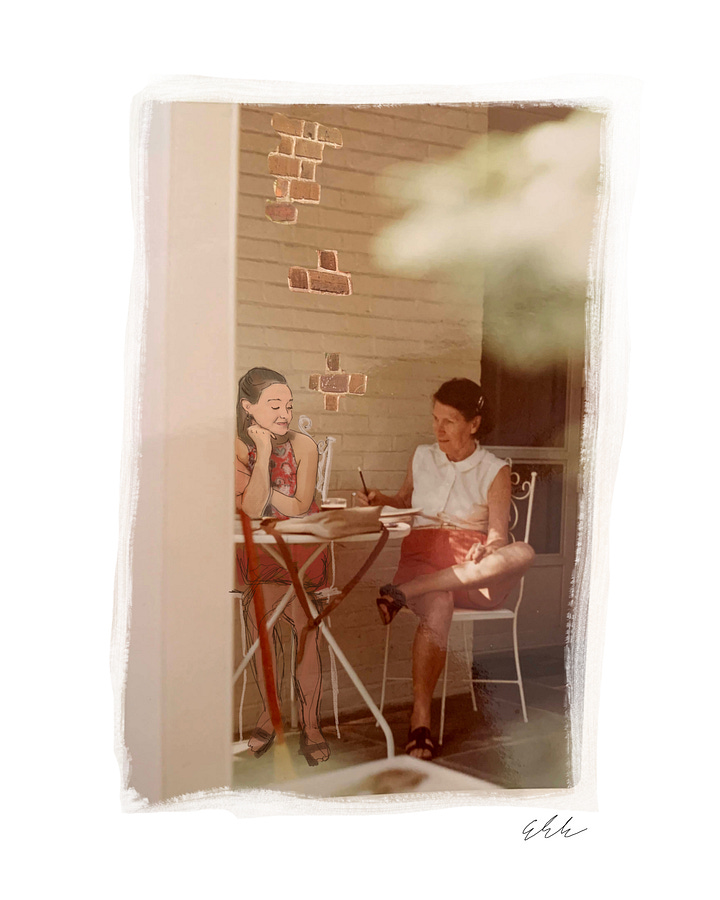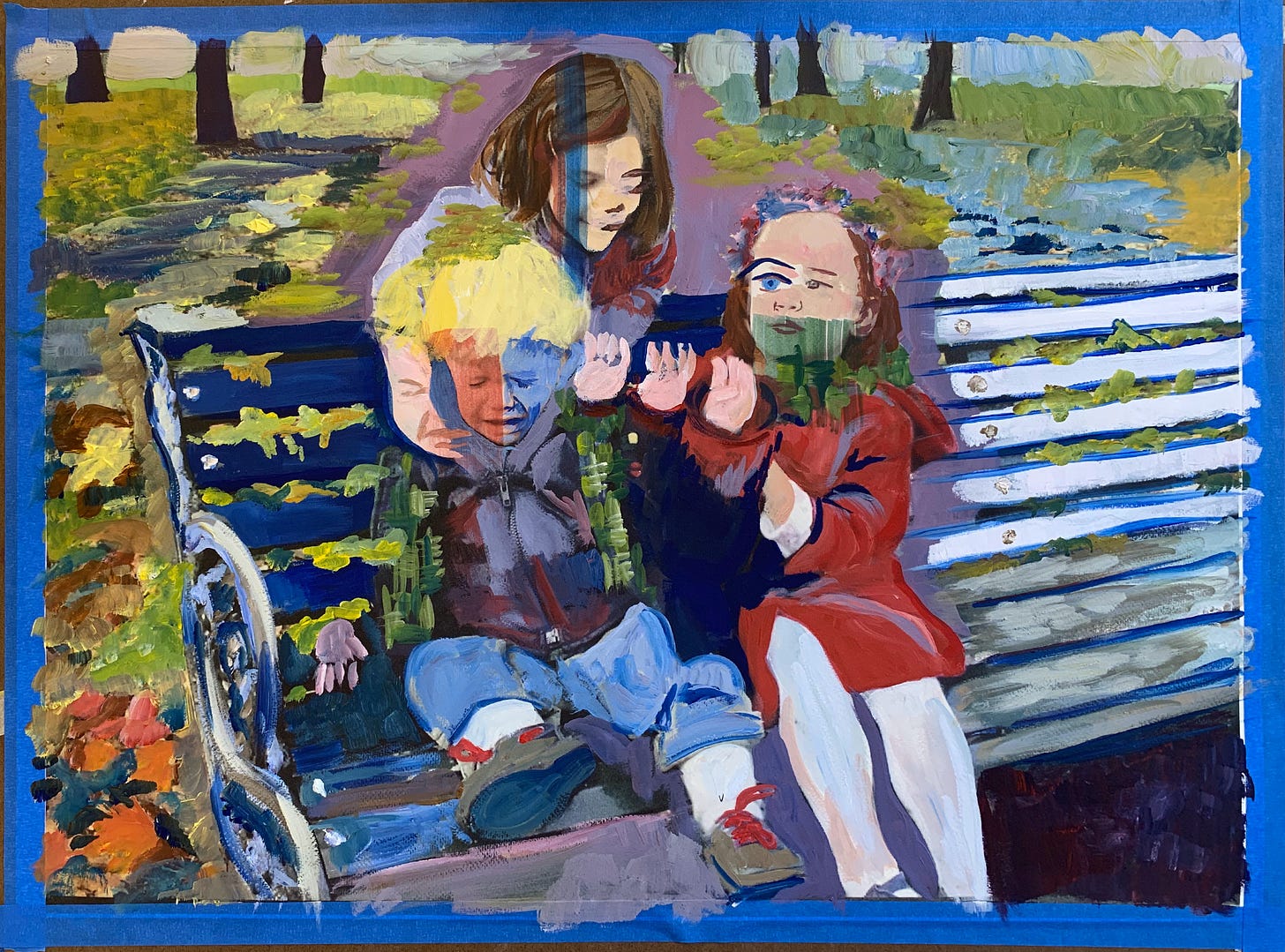The Palimpsest Scrapbook
pal·imp·sest | ˈpaləm(p)ˌsest | noun: something reused or altered but still bearing visible traces of its earlier form


Sarah Everett taught her son to drive at 10 years old. When she caught him smoking one of her cigarettes as a young boy, she didn’t chastise him. Instead, she invited him to join her next time. He never touched a cigarette again.
Her son sees her life as composed of three parts. The first is a life of general comfort and privilege. She was a smart girl, graduating from high school at 16 and college at 20. She won golf championships and rode horses. She married young and enjoyed a life of social gaiety with her husband. “They lived high through those times,” her son recalls.
When the war came, so began Sarah's second life. Her husband fell apart and Sarah fell into straitened circumstances that starkly contrasted with her previous life of relative opulence. Her resourcefulness allowed her to “buckle herself together” and she became a different person. She divorced and married again. By then, she had a baby girl to care for in addition to her two young sons. Her sons went to stay with various relatives, and eventually, she sent them both to a boarding school in Virginia for a more permanent solution. She learned to cook, among “other things that mothers should do that she had never done before.” She was no longer in the frenzy of socializing, and reneged on her previous “hands off” approach to mothering in order to provide for her new daughter.
This relative social quiet gave way to her third life, one of philosophical – Buddhist, even – comportment, of peaceful acceptance, tranquility, and dedication to her craft. A life-long sculptor, it wasn’t until Sarah’s later years that she took her art more seriously and began teaching at Queen’s college.
Sarah impacted everyone she met, and not always in the most positive of ways. She had a strong ego that made those close to her prickle at times. She was fascinating, demanding, and stubborn. She was a liberal among conservatives, a spiritualist among Episcopalians, an idealist among pragmatists, a tease among the poker-faced.
But among her family, she was beloved in spite, or perhaps, because of, her contrarian ways. Her son, who always called her Sarah (“well, that’s her name, isn’t it?”) never felt the antagonisms or frictions that often govern relationships between mothers and their children: “she was refreshing and relaxing to be around.” Similarly, her granddaughter can recall the excitement she felt whenever she went to visit her Grandma Sarah. The memories of poking around in her studio are the most distinct. She can even remember the smell of damp clay and pencil shavings. One had to make their way around the floor littered with scraps of paper, to watch for ink stains on table tops, and to avoid knocking down unfinished ceramic busts.
I can only imagine what Sarah’s studio smelled like. I never met my great-grandmother. I am often told how much we would have gotten along, if not for our love of art-making and teaching, then for our stubbornness, our proclivity for challenging norms, feeling deeply, and getting lost in rapturous debate. As I listen to my grandparents and my mother regale stories of her extraordinary character, I can’t help but feel swindled. How is it that I never got to meet the person in my family to whom I feel most connected? What would my visits with her have been like?
I imagine I am sitting at her feet as a young girl, playing absentmindedly but reveling in her presence as she sits down to write letters or draw. I imagine myself getting older, sitting at the table with her this time. I am watching her broad pencil strokes as she transfers an image onto the page. I do as she does, following the rhythmic scratching in the sketchbook.
The Palimpsest Scrapbook is an ongoing series where I explore the dissolution of linear time. Through art, I recreate connections and relationships between family members who may not have known each other, or perhaps, who didn't meet at the right time.
What would our relationships look like if we met each other at different stages of our lives? What would my 7-year-old or 23-year-old self have to say to Grandma Sarah in her later years? What if my 24-year-old brother were to meet me as an elementary student? Would he dote on me as I did him throughout our childhood? What if my mother and I, both in our sophomore year of college, could gossip about fickle friends and stumble around campus together at night? How would a conversation unfold between my present 27-year-old self and my father at the same age? Would we see each other more clearly?
Art allows me to renegotiate my memories by moving colors around, manipulating certain images, or transposing several pictures into one work. This gives me the chance to remember differently, to alter my relationship with that memory. A photograph is a still image; it doesn’t change, but the people inside the photographs are transformative and varying. Just like a photograph, a person can become immovable in our mind, and suddenly our relationships are no longer a dynamic connection between two transformative beings. Instead, our relationships engender a rigidity that makes us stuck, like a photograph gathering dust in a frame.
So, how might art’s manipulative and creative powers make us “unstuck”? How can it allow us to play with our memories, or recalibrate our perceptions of each other? How might it help us reimagine our relationships in a way that liberates us?








Yes! My mom's dad's mother. (Coker is my mom's mom!) That's a good question. I think first Memphis (!) and then a few places North Carolina.
Love this, Evie! So Sarah was your great grandmother on your mom’s side? Atlanta? NC? SC? A Coker?